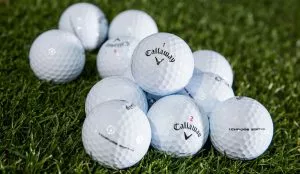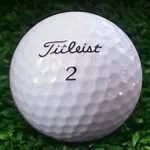Check out our golf ball comparison analysis below to find the right golf ball to suit your game. GDN has just the right ball for you at an affordable price! Be sure to browse GDN’s website to find the right ball for your game today!
Using Our Golf Ball Comparison Analysis To Select A Golf Ball to Improve Your Game!
Our golf ball comparison analysis is a useful tool in selecting the right golf ball as an integral part of your game. For golfers, choosing a ball that matches their playing style is the first step toward improving on-course performance. As you well know by now, not all golf balls are created equal. Golfers can select from several internal and external ball constructions, suited for players at every skill level.
Wide Selection of Golf Balls

Many golf balls are built with two-piece construction, composed of an inner solid core and external cover. This design delivers distance, durability, and the benefit of reduced spin. Therefore, a combination is best suited for less experienced players. Likewise, look for brands including Titleist, Callaway, TaylorMade, and Nike to produce top-performing golf balls in a variety of unique hues.
Most major golf ball manufacturers offer a wide array of balls. These are designed for specific golfers, from first-time novices to touring professionals. If you’re looking for a gift, personalized golf balls can make a work outing or wedding party event more unique.
Click on the text link below to browse GDN’s remarkable selection of quality golf balls/bags today! ⇓ https://www.jdoqocy.com/click-8400904-15441797
Looking For More? Check out the Titleist Pro V1 Golf Balls for an Accurate Shot and Lasting Durability.
How To Choose The Right Golf Ball?
Think about color when you’re selecting your golf ball. Similarly, selecting a distinct color helps golfers more easily track their ball in all weather conditions. This will allow for a more enjoyable round. It is especially true if a golfer has an eye condition making seeing their golf balls difficult in flight.
Furthermore, brands such as Callaway, Bridgestone, and Srixon have developed golf balls specifically for female swing speeds. These balls feature a soft cover and lower compression core for even greater distance and forgiveness on the green.
Experiment With A Variety Of Different Brands
When choosing your golf ball, golfers should try a variety of brands. After you have settled on a brand, playing with the same ball regularly will allow you to eliminate one variable in your game. Factor in compression ratings when looking for the perfect golf ball. Compression ratings of more than 100 are appropriate for golfers with a high swing speed. These are golfers who can carry drives more than 240 feet in the air. Those with slower swing speeds should select a ball with compression ratings between 80 and 90.
Equally important, more advanced players might look to a multi-layered golf ball. These balls are composed of a solid core and two to three internal layers. They are designed to produce better feedback and a higher spin. Multi-layer balls also enable golfers to manipulate their ball flight, while providing better control for shorter shots.
Golf Ball Comparison – Frequently Asked Questions About Golf Balls
What Is the Difference Between Golf Ball Piece Counts?
Modern golf balls range from two to six-piece constructions. The two-piece construction features a core layer and an outer cover. However, multi-layer golf balls feature a series of core/mantle layers and an outer cover. Therefore, deciding which golf ball construction is best for your game depends on your skill level, swing speed, and desired performance.
Which Golf Balls Are Best For Beginners?
Two-piece golf balls are often recommended for novice golfers. Larger core construction maximizes distance while minimizing spin. This results in longer shots with greater accuracy. The thicker cover construction is also more durable, which can be an important factor if the golfer hits a wayward shot. Therefore, these balls are ideal for golfers with lower swing speeds because of the added distance, penetrating trajectory, and reduced side spin they deliver.
Which Golf Balls Are Best For More Experienced Golfers?
Multi-layer golf balls are better suited for experienced, mid- to low handicappers. The series of core/mantle layers enhance control and feel to allow golfers to sculpt shots and generate shot-stopping spin commands around the green. The thinner cover construction also increases spin control while providing the soft, crisp feel serious golfers want. The elevated levels of control and performance a golfer can achieve with multi-layer golf balls make them popular with players who have faster swing speeds and more consistent swing characteristics.
Why Do Golf Balls Have Dimples And Why Are Dimples So Important?
It’s commonly said that dimples make the golf ball fly, similar to the wings on a plane. Environmental factors, such as drag, slow the golf ball the instant it leaves your clubface. Dimples create a thin layer of air that clings to the surface and travels around the back of the golf ball, which increases lift and decreases both wake and aerodynamic drag. Testing proves that dimples make a difference. Without them, golf balls travel a significantly shorter distance and fly with far less predictability.
Varying dimple shapes, patterns, and sizes affect distance, the stability with which the golf ball flies, and spin rates on both full and partial shots, so manufacturers are continuously testing and working to improve them.
What Is Golf Ball Compression?
Core compression refers to the overall density of the golf ball. The low-compression golf balls, with a rating of 60–80, were originally designed for novices, juniors, females, and senior golfers. However, skilled golfers are also starting to use them. The lower compression rating of these “soft” golf balls allows for more deformation of the golf ball at impact, especially with metals and longer irons. This deformation reduces spin rates on low- and mid-lofted clubs, which results in straighter ball flight and increased distance. When using short irons and wedges, contact between the clubface and golf ball is prolonged, resulting in a softer feel compared to golf balls with higher compression.
Higher compression golf balls, with a rating of 90 and above, are typically designed for more experienced golfers with faster swing speeds. Since high-compression golf balls are harder to deform and spend less time on the clubface, golfers with more aggressive swing speeds can achieve greater command and control over the golf ball.
Can the Use of a Damaged or Scuffed Golf Ball Affect My Performance?
Yes, it can, and it often does! Your golf ball’s cover layer is constructed to exact specifications to consistently perform a certain way. Cuts, scuffs, and other damage to the exterior compromise those specifications and cause your golf ball to perform in an unpredictable, unintended way.
Imperfections On Your Golf Ball Will Affect How It Performs!
Imperfections in the ball’s cover change the way air and drag interact with the golf ball and ultimately result in the loss of distance and accuracy. For example, if some dimples are shallower than others because of a scuff mark, your shot could end up anywhere from 3–5 yards offline and up to 6 yards shorter than your intended distance. It’s important to monitor the condition of your golf ball to ensure it is performing properly.
High-quality, multi-layer golf balls commonly feature softer cover compounds, such as urethane. They tend to resist cutting on poor clubface contact. However, these materials are more susceptible to cuts when the ball comes in contact with harder surfaces like trees and cart paths. Two-piece golf balls, or golf balls with lower core compression, often feature firmer cover compounds, such as ionomer. These tend to be more durable and resist cuts on both poor strikes and contact with hard surfaces.
Which Golf Balls Do The Professionals Use?

While many different golf ball brands are used on Tour, the brand that’s most used on Tour is Titleist. The majority of professionals play Titleist Pro V1 or Pro V1x.
How Can I Make Sure I Choose The Best Golf Ball For Me?
You can make sure you’ve picked the right ball for your needs by visiting your pro shop or local store for a golf ball fitting. The above analysis is an excellent resource for data on various golf balls. Once you’ve picked a golf ball, it’s important to stick with it for a few rounds so you can understand how it performs.
Personal Tip: “Follow our golf ball comparison analysis and you will find the right ball to fit your unique playing style!”
